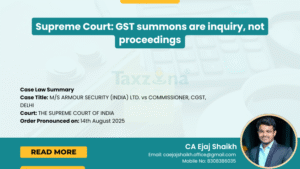Did you know that every business needs to file a GST return? In this blog post, we will explain what GST is, the different types of returns that a business needs to file, and the deadline for filing them. Let us help you get started with your GST return filing in Mumbai and keep you informed about the latest changes and tax rulings related to the GST. Thank you for reading!
What is GST?
GST is the Goods and Services Tax that was implemented in India on July 1, 2017. It is a tax that replaces all previous indirect taxes, including the Central Sales Tax (CST). The main purpose of Types of GST in India- CGST, SGST & IGST – Nicely Explained is to reduce tax evasion and help create a more efficient tax system. There are three types of GSTR -GST Return, Input Credit Scheme (ICS), and Refund Mechanism for Exempted Items (RMEI).
GST returns are filed by businesses who have taxable supplies of goods and services for gst registration online. ICS is a credit scheme that allows businesses to claim input tax credit for the goods and services they use in the course of their business. RMEI is a refund mechanism that allows tax-payers to claim a refund of the tax they have paid on the goods and services they have bought from registered dealers.
How to file GST returns online?
Goods and services tax (GST) is a tax that applies to most goods and services sold in India. As a taxpayer, you need to file GST returns online at the GST portal https://www.gstportal.gov.in/.
There are three types of GSTR you may have to file – value-added tax (VAT), central sales tax (CST), and integrated transport service tax (ITS). All taxpayers including individuals, companies, cooperatives, charities and trusts need to register for GST under the relevant taxation law – income tax return filing or company act if they generate taxable supplies relating to business activities carried out through any permanent establishment situated in India.
Make sure you are registered and file your returns on time to avoid late payment penalties and interest. GST is a complex tax and it is important to seek professional help if you have any questions.
What are the types of GSTR ?
There are three types of GSTR that every taxpayer needs to be aware of- GST on Transactions, GST return & settlement, and Central registration depository (CRD). If you have an annual turnover of more than Rs 50 crore, you have to file your return online through the e-filing portal. If your annual turnover is below Rs 50 crore, you can file your return either through the e-filing portal or designate a registered agent for filing returns on behalf of the assessee and How to file GST Registration – Process, Benefits & Penalty.
In addition to filing returns, taxpayers need to keep track of the due date of their return and make payment of the tax due. Make sure to stay up-to-date with the latest tax updates and regulations by reading our blog regularly.
Who needs to file a GST return?
If you’re a business owner in India, you need to file a GST return. This tax return is mandatory for businesses with annual sales of $.5 million or more. Additionally, if you’re an individual who is not a business owner, you don’t need to file a GST return. However, it’s still important to keep track of your tax obligations as filing the return may help reduce your tax liabilities in the future. You can know more about the importance of GST. There are five types of GSTR that a business owner may encounter:
- Supply of goods and services;
- Importation of goods from outside India
- Employment or self-employment
- Demat account transactions
Property Transactions. It’s important to remember that filing the return is voluntary, but it could help you to understand your tax situation and make informed decisions in the future.
Types of GST returns that a business needs to file?
As a business, it’s important to stay tax-in-the-know. That’s why it’s essential to file returns every year, no matter the type of income you generated. Here’s a quick summary of the types of returns that a business needs to file:
- A return is needed if the business earned or realized a taxable amount in the GST Reporting period.
- The types of returns that need to be filed depend on the type of taxable income: input tax, SGST, and CENVAT credit.
- There are three different types of returns – GSTR-1, GSTR-2A & GSTR-3 – corresponding to these three categories of taxable income.
It’s important for businesses to get accurate information about their transactions so they can properly file their returns. With the help of an accountant or tax consultant, filing returns can be made easier and more streamlined.
Conclusion
In this blog, we have explained the basics of GST and the different types of returns that a business needs to file. We have also provided instructions on how to file the returns online. So, if you are a business owner, make sure to check out the blog and learn everything you need to know about GST!
Frequently Asked Questions
Taxpayers have to file their returns online by the due date (31st March of every year). If you have complex tax issues or you need help filing your return, you can always get in touch with a registered tax agent. In addition, you can also file your return using the electronic return filing (ERF) system.
This system is available online and allows you to submit your return without having to visit a tax office. Once you've filed your return, you'll receive a print-out of the same for your records. Finally, if you are an entrepreneur who earns income from outside of India, then you will need to file your CVDT return.
This is applicable if the total value of your business activities in India is more than Rs 50 lakhs (1 crore). If you produce goods in India and supply them across state borders, then you will need to register for IGST.
This is applicable if the value of the goods and services supplied exceeds Rs 2 crore (2 million). Lastly, if you provide services in India, then you will need to file the GST return. This applies to any service that is considered a taxable activity under the Indian tax law.
Yes, you can e-file your GST returns even if you are not registered with the IT Department. You need to have an active EMI account number and a valid email address to file through GST Portal. To e-file your return, simply login to www.gstportal.gov.in and click on 'File My Return' under 'My Account'. The return form will open in a new window - just enter all the required information and hit submit!




